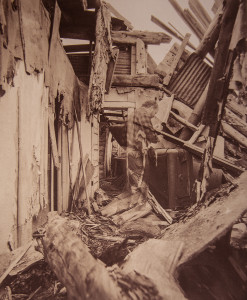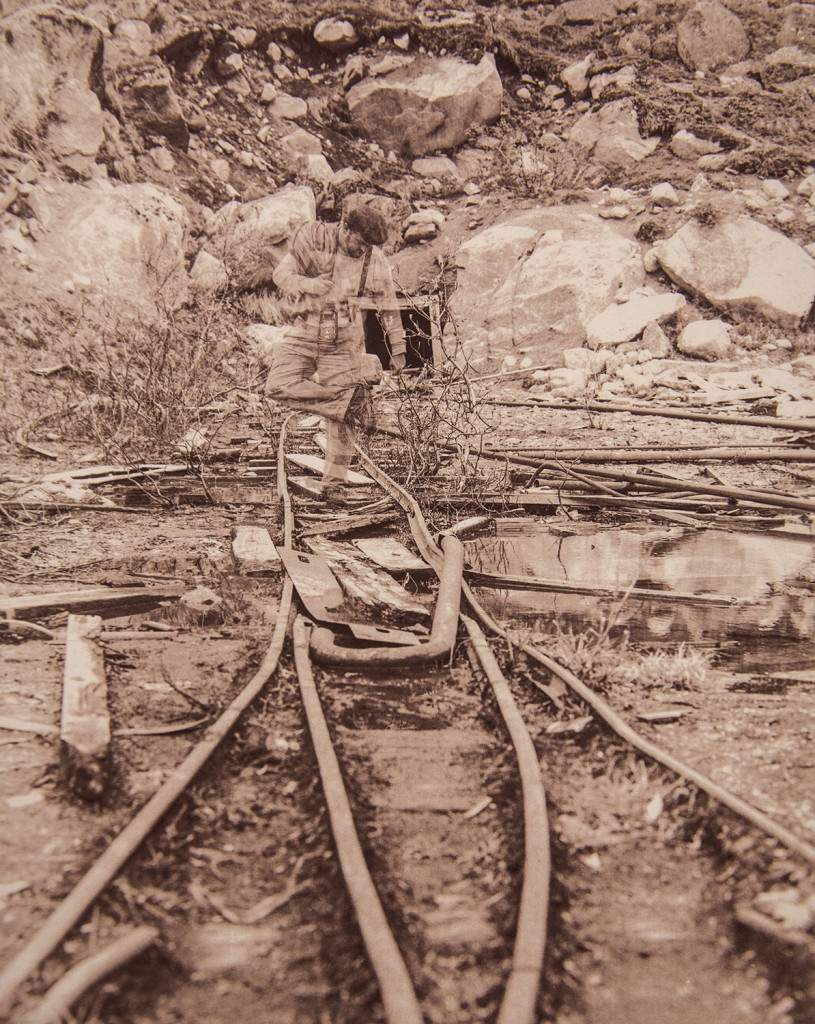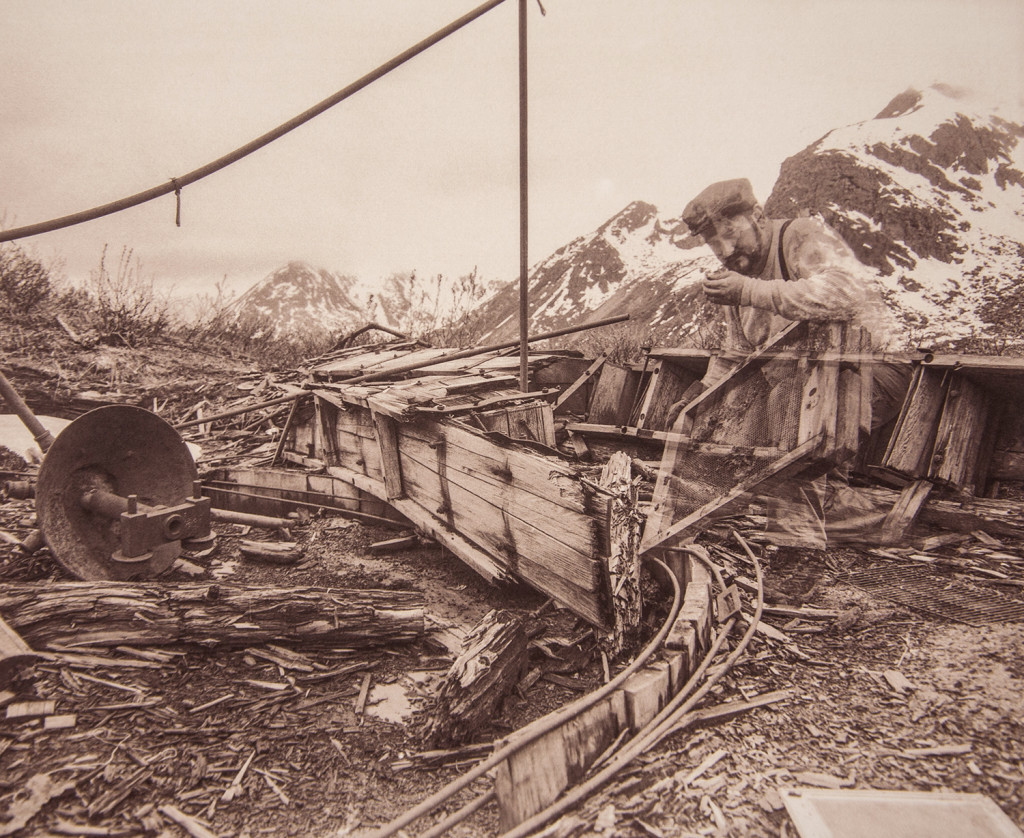
Earlier this Summer, I spent a long weekend traveling approximately 1000 miles looking for new shooting locations for my (now completed) Thesis Project. The trip had me driving my FJ Cruiser down to Paxson (to capture the Paxson Lodge ruins), across the 135-mile long unpaved Denali Highway (to hunt for Valdez Creek mining ruins) and down to the Kenai Peninsula (in search of Palmer Creek mining ruins). Aside from Paxson, the trip was a total bust – and with even that, I hesitated to say I had anything that would fit very well in my final series. Valdez Creek and the town of Denali had been razed in the 70s (by BLM or by local landowners, depending on who you ask) and little remained except for three cabins – with very little original about them except their shells. The trip to Hope and the nearby Palmer Creek was cut short when snow (in mid June) blocked the path as we attempted to ascend ~900 feet on the side of a mountain up a zig-zagged alder-covered mining road. Anyone that knows me knows that snow doesn’t stop me – but snow at a 45 degree slant with nothing to grab onto? That’ll do it. I ended up sliding 30-50 feet down the mountain with one attempt and decided it wasn’t worth getting hurt. My hiking poles paid for themselves that day, as they easily kept the slide from being a couple extra hundred feet long.
That said, I was determined. Stubborn. I was going to get something out of this trip. Brian Yarmak (an awesome ANC-based friend of mine) was kind enough to tag along during the Palmer Creek hike and was even willing to sacrifice yet another day out of his weekend to try to get a successful photo shoot out of my excursion down south. Thankfully, a last-minute decision to try out Archangel Valley in Hatcher’s Pass provided some amazing material that rounded out my series quite nicely.
I consider Hatcher’s Pass to be the closest thing to God’s Country I’ve ever seen; it’s beauty unbridled and untamed, the Pass is a rare treat in Alaska because the summer tourists rarely flock to it. From mining history to alpine peaks, glacier-fed iridescent blue/green lakes to the amazing flora, it truly offers everything Alaska is. I’ve spent several weekends in the past two years photographing for my Thesis Project up in Hatcher’s and they’ve included:
- a 3-mile hike up and down 600 vertical feet in March with four feet of snow below me, 60 lbs of gear on my back and 40 mile per hour winds beside me – all for a single picture. To be honest, it’s still my favorite picture of the entire series. It’s epic. Actually, I did this hike twice in nearly the same weather conditions – one for my Midpoint Review material and one for my actual Thesis. The wind the second time really made the shot!
- a 6-mile hike up Gold Cord Valley last summer to try to reach Lonesome Mine – only to find that outdated Topo maps failed to mention no actual bridge existed across the raging Little Susitna. The dud of a trip was made an even greater failure when I realized, upon returning to my car, that I had lost my GPS unit at the turnaround point – this required a return trip up the trail the next day to retrive it.
- a 3-5 mile hike up 1100 vertical feet on Skyscraper Peak with Rob Prince last summer to explore Martin Mine. A beauty of a hike – but still quite a beast of a haul up that mountain with studio-style medium format gear.
- a fun 2-mile hike with the Family up to Gold Cord Lake, which had me photographing at an abandoned sod-sided cabin on the way up.
This time, however, I decided to try for a mine I’d never been to – Fern Mine up Archangel Valley. Surprisingly, although the weather was obscenely poor, it never started raining on us even though the entire Pass is a catchall for weather systems coming up the Cook Inlet – but the overcast conditions did make me very weary of what sort of quality I’d get out of the resulting Van Dykes. My main reason for going to Fern was that I realized my project was lacking a few mining “essentials” – elements that would solidify the series’ connection to early mining. I had no sluice boxes, no mining carts, as well as no shafts or adits. Interior Alaskan mines (from this era) are all but collapsed…or they’ve been long bulldozed over and spat out the backend of a Gold Dredge 60 years ago. The Hatcher’s Pass mines are hard rock – they go straight into the mountain and will most likely be there after yet another 100 years of weathering. Fern, I knew, had an accessible mine portal – and so Brian and I made the 4.5 mile hike up 1100 feet of mountain for a hole… in a mountain.

As you approach Fern Mine, however, it doesn’t look like much – decades of on-and-off mining has left the valley floor an entire mess with artifacts from the 20s and 30s easily mixing with material from the 80s. What I got, however, was much more than I could’ve ever expected. Look hard enough and you begin to find the gems. The outline of old wooden water/chemical holding tanks (perhaps cyanide leeching tanks) with metal-grated sluice boxes sitting dormant for probably six or seven decades. The criss-cross pattern of weather-worn cart tracks leading into the side of a mountain. The massive machinery – from water turbines to Caterpillar-style diesel engines – litter dozens of acres of pristine wildlife, all in the midst of being taken over by Mother Nature. The wood-staved 1-foot pipe that still meanders its way up the side of a mountain to a natural reservoir. There’s beauty amongst this junk – stories that define early modern Alaskan history – and it all fit snugly into exactly what my project needed in the 11th hour. I spent probably more than an hour surveying the entire scene with Brian, another two hours setting up three scene shots and several hours just reveling in the beauty of Alaska during less-than-optimal weather conditions.

The VDBs turned out amazing. I was truly excited by each of them – and I’ve still got more material to visit later on. Although I say my Thesis Project is complete, my work on Stories Fading Fast continues as I look to incorporate even a wider set of locales over the next year. Please feel free to leave me your thoughts or critique in a comment on the blog, through Obscura Works on Facebook or Twitter – or drop me a line in my email/contact form.

+There are no comments
Add yours